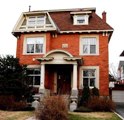
Edwardian Classicism (1900 – 1920)
By 1900, most architecture was reflecting a revival of some sort from pre-Victorian times, (see Period Revivals, Colonial Revival, Classical Revival, Gothic Revival). Like the Georgian and Regency Styles, Edwardian Classicism is associated with the reign of an English monarch. Edward VII, son of Queen Victoria, reigned between 1901 and 1910. The style is a precursor to the simplified styles of the 20th century.
Edwardian Classicism provides simple, balanced designs, straight rooflines, un-complicated ornament, and relatively maintenance-free detailing. These buildings generally have a smooth brick surface and many windows. Many of the Classical features – colonettes, voussoirs, keystones, etc. – are part of this style, but they are applied sparingly and with guarded understatement. Finials and cresting are absent. Cornice brackets and braces are block-like and openings are fitted with flat arches or plain stone lintels.